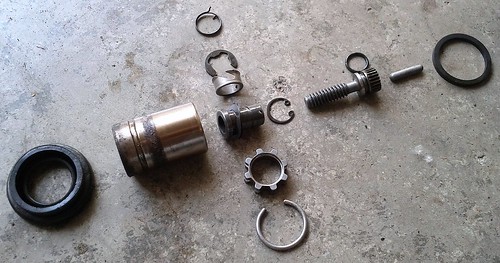I posted on this issue in a different thread yesterday, but after reading up on this it seems like most people have a different brake-seizing problem to mine.
Other people find that the little allen-socket adjustment gear seizes or strips--mine turns fine in both directions, but the piston doesn't move. I removed the adjustment gear, and both it and the mating gear look to be in good shape. I can feel very slight wobbling movement with my fingers while turning the adjustment gear, but no in-out movement. Bottom line is I can't retract the piston to get the caliper over the new pads. Is this another variety of seized caliper, or is there something else I can do?
Details
The fact that the RL rotor was cooler may indicate that the piston has been stuck for some time, keeping the pads in contact with the rotor but not applying much braking force. This may also explain the e-brake not working well. It may be that the RR brake has been doing all the work.
Thoughts?
Other people find that the little allen-socket adjustment gear seizes or strips--mine turns fine in both directions, but the piston doesn't move. I removed the adjustment gear, and both it and the mating gear look to be in good shape. I can feel very slight wobbling movement with my fingers while turning the adjustment gear, but no in-out movement. Bottom line is I can't retract the piston to get the caliper over the new pads. Is this another variety of seized caliper, or is there something else I can do?
Details
- This is the driver-side rear caliper. The piston on the passenger side retracted fine.
- Over the past couple of weeks, I had noticed that the RL rotor was cooler than the other three after driving some distance: The RL rotor was hot to the touch while the other three were too hot to touch for more than a second or so. Plus, the e-brake needed to be almost at the limit of its travel to hold the car.
- Both sets of rear pads were worn unevenly, with the outer pads more worn than the inner (~3.3mm on the outside vs. ~4.5mm on the inside), which seems odd. The rotors are both at ~9.2mm.
- I removed the cap from the brake fluid reservoir before trying to retract the piston.
The fact that the RL rotor was cooler may indicate that the piston has been stuck for some time, keeping the pads in contact with the rotor but not applying much braking force. This may also explain the e-brake not working well. It may be that the RR brake has been doing all the work.
Thoughts?


